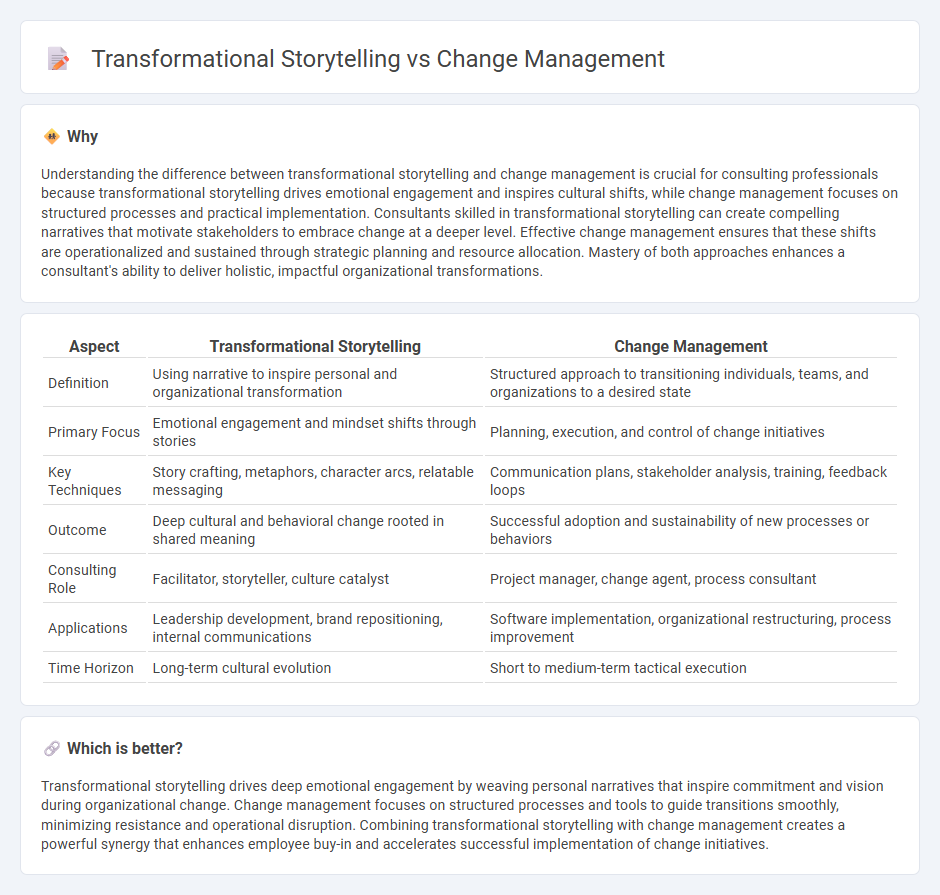
Transformational storytelling enables organizations to inspire deep emotional engagement by weaving compelling narratives that illustrate the human impact of change, driving cultural shifts more effectively than traditional change management methods focused on processes and systems. By leveraging storytelling techniques, leaders can foster trust, clarity, and motivation throughout the transition, enhancing adoption and long-term commitment. Discover how integrating transformational storytelling can elevate your change initiatives and achieve lasting organizational transformation.
Why it is important
Understanding the difference between transformational storytelling and change management is crucial for consulting professionals because transformational storytelling drives emotional engagement and inspires cultural shifts, while change management focuses on structured processes and practical implementation. Consultants skilled in transformational storytelling can create compelling narratives that motivate stakeholders to embrace change at a deeper level. Effective change management ensures that these shifts are operationalized and sustained through strategic planning and resource allocation. Mastery of both approaches enhances a consultant's ability to deliver holistic, impactful organizational transformations.
Comparison Table
| Aspect | Transformational Storytelling | Change Management |
|---|---|---|
| Definition | Using narrative to inspire personal and organizational transformation | Structured approach to transitioning individuals, teams, and organizations to a desired state |
| Primary Focus | Emotional engagement and mindset shifts through stories | Planning, execution, and control of change initiatives |
| Key Techniques | Story crafting, metaphors, character arcs, relatable messaging | Communication plans, stakeholder analysis, training, feedback loops |
| Outcome | Deep cultural and behavioral change rooted in shared meaning | Successful adoption and sustainability of new processes or behaviors |
| Consulting Role | Facilitator, storyteller, culture catalyst | Project manager, change agent, process consultant |
| Applications | Leadership development, brand repositioning, internal communications | Software implementation, organizational restructuring, process improvement |
| Time Horizon | Long-term cultural evolution | Short to medium-term tactical execution |
Which is better?
Transformational storytelling drives deep emotional engagement by weaving personal narratives that inspire commitment and vision during organizational change. Change management focuses on structured processes and tools to guide transitions smoothly, minimizing resistance and operational disruption. Combining transformational storytelling with change management creates a powerful synergy that enhances employee buy-in and accelerates successful implementation of change initiatives.
Connection
Transformational storytelling enhances change management by creating compelling narratives that articulate the vision, purpose, and benefits of change, thereby fostering employee engagement and reducing resistance. Effective storytelling aligns stakeholders' emotions and values with organizational goals, making complex change initiatives relatable and actionable. This synergy accelerates adoption, strengthens leadership influence, and ensures sustainable transformation across the enterprise.
Key Terms
**Change management:**
Change management emphasizes structured processes, stakeholder engagement, and clear communication to facilitate organizational transitions effectively. It employs tools like impact assessments, training programs, and feedback loops to ensure smooth adoption of new strategies or technologies. Discover how mastering change management drives sustainable growth and minimizes resistance in your organization.
Stakeholder engagement
Change management emphasizes structured processes and clear communication to engage stakeholders, ensuring alignment with organizational goals and minimizing resistance. Transformational storytelling leverages compelling narratives to foster emotional connections, inspire commitment, and drive deeper stakeholder involvement in change initiatives. Explore the distinct methods of stakeholder engagement in change management and transformational storytelling to optimize your organizational change efforts.
Communication planning
Change management emphasizes structured communication planning to ensure clear, consistent messaging that facilitates employee adaptation and minimizes resistance during organizational shifts. Transformational storytelling leverages compelling narratives to emotionally engage stakeholders, foster a shared vision, and drive cultural change through storytelling techniques integrated into communication plans. Explore how blending strategic communication planning with transformational storytelling can amplify change initiatives effectively.
Source and External Links
What is Change Management? - IBM - Change management is a structured approach organizations use to communicate, implement, and support people and processes through organizational transitions, aiming to help stakeholders adopt new ways of working more effectively.
What is Change Management? Definition & Process - WalkMe - Change management is a systematic process for guiding the human side of organizational change, involving clear vision-setting, training, resistance management, and ongoing monitoring to embed lasting change.
What is Change Management? Organizational, Process ... - ASQ - Change management encompasses the methods a company uses to define, communicate, and implement change across internal and external processes, with an emphasis on risk assessment, planning, and cross-functional teamwork.
 dowidth.com
dowidth.com